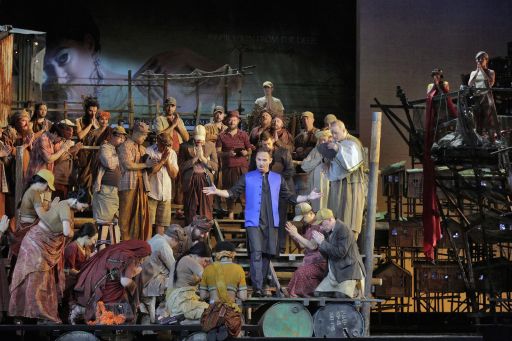New York, Metropolitan Opera, Season 2015 /2016
“LES PÊCHEURS DE PERLES”
Opera in three acts. Libretto by Eugène Cormon and Michel Carré
Music by Georges Bizet
Music by Georges Bizet
Zurga MARIUSZ KWIECIEN
Nadir MATTHEW POLENZANI
Leïla DIANA DAMRAU
Nourabad NICOLAS TESTÉ
Metropolitan Opera Chorus and Orchestra
Conductor Antony Walker
Chorus Master Daniel Palumbo
Production Penny Woolcock
Sets Dick Bird
Costumes Kevin Pollard
Lighting Jen Schriever
Projection Design 59 Productions
Movement Director Andrew Dawson
New Production
New York, January 27, 2016
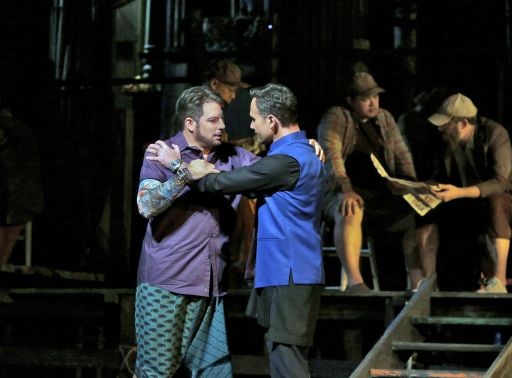 For its first production of Les Pêcheurs des Perles in a hundred years, the Met has done itself proud, chorus and orchestra acquitting themselves magnificently, cast highly capable and attractive (the Golden Age Met cast, Hempel, Caruso and De Luca, didn’t make much of the piece) and a production that made superb, atmospheric use of lights, screens, projections and subtle movements of fabric to give us the sea beside a wharfside slum on a turbulent, sometimes raging Indian Ocean. Pearl divers “swam” in a sea the five-story height of the stage during the prelude and tenements wavered into tides and surf. Audiences loved it, and it bids fair to be the hit of the current season. Penny Woolcock’s staging is roughly contemporary, electric lights and billboards in the background, a TV set and a small refrigerator up front, and the men wearing T-shirts. Zurga, the chief of a band of pearl divers who, naturally because it’s Mariusz Kwiecien, removes his T-shirt at least once, pays off the voters and gives out souvenir fans that reproduce his face.
For its first production of Les Pêcheurs des Perles in a hundred years, the Met has done itself proud, chorus and orchestra acquitting themselves magnificently, cast highly capable and attractive (the Golden Age Met cast, Hempel, Caruso and De Luca, didn’t make much of the piece) and a production that made superb, atmospheric use of lights, screens, projections and subtle movements of fabric to give us the sea beside a wharfside slum on a turbulent, sometimes raging Indian Ocean. Pearl divers “swam” in a sea the five-story height of the stage during the prelude and tenements wavered into tides and surf. Audiences loved it, and it bids fair to be the hit of the current season. Penny Woolcock’s staging is roughly contemporary, electric lights and billboards in the background, a TV set and a small refrigerator up front, and the men wearing T-shirts. Zurga, the chief of a band of pearl divers who, naturally because it’s Mariusz Kwiecien, removes his T-shirt at least once, pays off the voters and gives out souvenir fans that reproduce his face.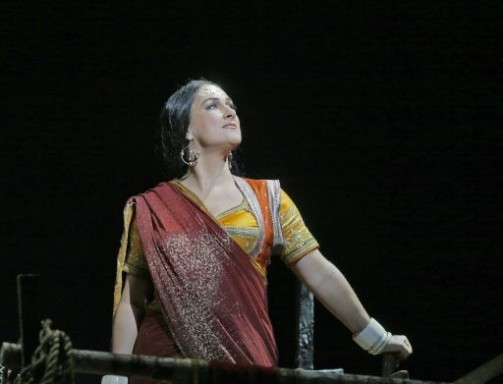 Since Sri Lanka, thanks to its long civil war, is almost as unknown to modern audiences as Ceylon was to the Parisians of 1863, the notion that this community survives by choosing an annual priestess to remain veiled to all men while invoking Brahma to bless their efforts does not outrage common sense, as so many opera updatings tend to do. Still: The opera is slight, boilerplate romanticism. There is little in this story to suggest the sharp inventions of fascinating psychological drama that Bizet would come up with twelve years later. The score is a lovely, imaginative thing, full of skillful orchestral depictions of water bubbling, rushing, surging, storming about, and little “exotic” dances to the rhythm of tiny bells—though as Dick Bird’s set pushes the chorus and the wharf onto bleachers close to the edge of the stage, there is no room for dancing, even when the locals tell us that is what they are supposedly doing. All Met stagings nowadays seem to be pushed to the front, as if there were no room for them to walk across the floor; I do not know if this is because the HD telecasts of these productions require the singers to stand there or because singers nowadays have smaller voices than they had in, say, the 1990s, when they still often sang from the middle or rear of the vast stage. It means there isn’t much room for them to act and
Since Sri Lanka, thanks to its long civil war, is almost as unknown to modern audiences as Ceylon was to the Parisians of 1863, the notion that this community survives by choosing an annual priestess to remain veiled to all men while invoking Brahma to bless their efforts does not outrage common sense, as so many opera updatings tend to do. Still: The opera is slight, boilerplate romanticism. There is little in this story to suggest the sharp inventions of fascinating psychological drama that Bizet would come up with twelve years later. The score is a lovely, imaginative thing, full of skillful orchestral depictions of water bubbling, rushing, surging, storming about, and little “exotic” dances to the rhythm of tiny bells—though as Dick Bird’s set pushes the chorus and the wharf onto bleachers close to the edge of the stage, there is no room for dancing, even when the locals tell us that is what they are supposedly doing. All Met stagings nowadays seem to be pushed to the front, as if there were no room for them to walk across the floor; I do not know if this is because the HD telecasts of these productions require the singers to stand there or because singers nowadays have smaller voices than they had in, say, the 1990s, when they still often sang from the middle or rear of the vast stage. It means there isn’t much room for them to act and 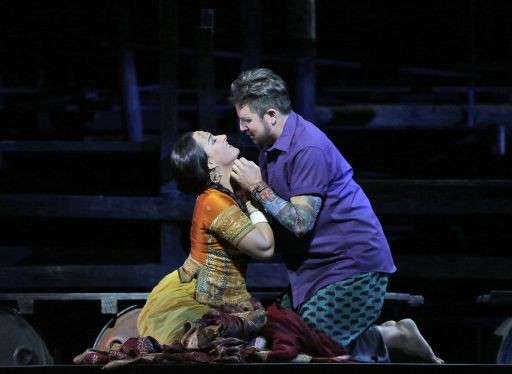 less for dances, set pieces, rituals and so forth. The cast, three of them Met stalwarts, gave beautifully calculated performances of the cardboard characters they were called upon to play. Matthew Polenzani, best known as a Mozartean, sang Nadir with elegant line and elegant French, plus a smooth, effortless rise to head voice in “Je crois entendre encore.” He mingles this sound beautifully with Kwiecien, his partner in many a superb Così fan tutte, and their “Au fond du temple saint” would surely have been encored if current Met custom permitted such things. Kwiecien, as is almost always true (except in Mozart), is inclined to yell whenever the drama reaches a point of passion, as it does at the conclusion of Act II and in his Act III aria, “L’orage est calmé.” This is a great pity, as his voice, though never sizable, has a suave and sinister beauty when he does not force it that have made his Don Giovanni and Count Almaviva so effective. But his inability to maintain self-control implies that he will never be much of a Verdi singer. Diana Damrau has become more of a singing actress with coloratura in her arsenal than the sort of canary who specializes in the Queen of the Night. Manon and Violetta have offered her opportunities to flesh out a line with acting, and she has taken them. But there isn’t much to Leïla besides the “exotic” coloratura, and Damrau’s lovely cool soprano turns white at the top, and her trill is quite colorless. She gave a fine, committed performance but I never understood the character’s motivations. No doubt her discomfort when Woolcock obliged her to sing a duet while Polenzani was unhooking her lingerie had something to do with it. Soft-porn is the current operatic
less for dances, set pieces, rituals and so forth. The cast, three of them Met stalwarts, gave beautifully calculated performances of the cardboard characters they were called upon to play. Matthew Polenzani, best known as a Mozartean, sang Nadir with elegant line and elegant French, plus a smooth, effortless rise to head voice in “Je crois entendre encore.” He mingles this sound beautifully with Kwiecien, his partner in many a superb Così fan tutte, and their “Au fond du temple saint” would surely have been encored if current Met custom permitted such things. Kwiecien, as is almost always true (except in Mozart), is inclined to yell whenever the drama reaches a point of passion, as it does at the conclusion of Act II and in his Act III aria, “L’orage est calmé.” This is a great pity, as his voice, though never sizable, has a suave and sinister beauty when he does not force it that have made his Don Giovanni and Count Almaviva so effective. But his inability to maintain self-control implies that he will never be much of a Verdi singer. Diana Damrau has become more of a singing actress with coloratura in her arsenal than the sort of canary who specializes in the Queen of the Night. Manon and Violetta have offered her opportunities to flesh out a line with acting, and she has taken them. But there isn’t much to Leïla besides the “exotic” coloratura, and Damrau’s lovely cool soprano turns white at the top, and her trill is quite colorless. She gave a fine, committed performance but I never understood the character’s motivations. No doubt her discomfort when Woolcock obliged her to sing a duet while Polenzani was unhooking her lingerie had something to do with it. Soft-porn is the current operatic 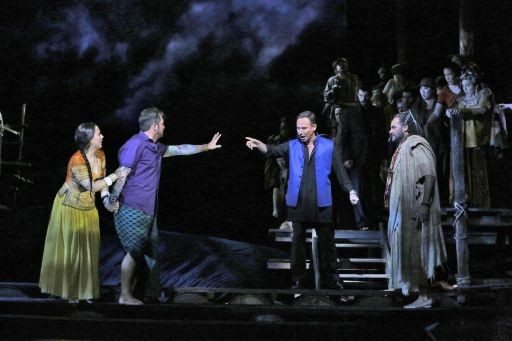 staging style, but singers are frankly embarrassed by it and I wish directors would grow up and realize it doesn’t work. They’re singing about love. Let them stand there or cuddle and sing about love. Rolling on the floor leaves nothing, or the wrong things, to the imagination. The most effective singing of the night came in the small role of Nourabad, the high priest (always a bad guy in Orientalist opera or ballet), from Nicolas Testé, also the only native Francophone in the cast. The orchestral performance, like the choral one, was dreamy and impeccable. The use of Bizet’s “pre-leitmotivs” and their exquisite assignment to this instrument or that made a seamless completeness of this slight story. One understood why Berlioz admired the piece when it was new, and what experiments Bizet was making that would eventually lead him to Carmen and, tragically, no further. He already knows how to make a tune mean something, and how to get it to stick in the memory for dramatic return. There isn’t much depth to this opera, but it is a joy to hear it now and then given such first-class treatment by all hands. By chance, I attended the performance conducted by Antony Walker the one night it was not led by Gianandrea Noseda (whom I had heard at another performance), but everything fell exquisitely into place at Walker’s hands and both men have the right notions of what should and what cannot be done to make this delicate thing memorable. Photo by Ken Howard/Metropolitan Opera.
staging style, but singers are frankly embarrassed by it and I wish directors would grow up and realize it doesn’t work. They’re singing about love. Let them stand there or cuddle and sing about love. Rolling on the floor leaves nothing, or the wrong things, to the imagination. The most effective singing of the night came in the small role of Nourabad, the high priest (always a bad guy in Orientalist opera or ballet), from Nicolas Testé, also the only native Francophone in the cast. The orchestral performance, like the choral one, was dreamy and impeccable. The use of Bizet’s “pre-leitmotivs” and their exquisite assignment to this instrument or that made a seamless completeness of this slight story. One understood why Berlioz admired the piece when it was new, and what experiments Bizet was making that would eventually lead him to Carmen and, tragically, no further. He already knows how to make a tune mean something, and how to get it to stick in the memory for dramatic return. There isn’t much depth to this opera, but it is a joy to hear it now and then given such first-class treatment by all hands. By chance, I attended the performance conducted by Antony Walker the one night it was not led by Gianandrea Noseda (whom I had heard at another performance), but everything fell exquisitely into place at Walker’s hands and both men have the right notions of what should and what cannot be done to make this delicate thing memorable. Photo by Ken Howard/Metropolitan Opera.
 For its first production of Les Pêcheurs des Perles in a hundred years, the Met has done itself proud, chorus and orchestra acquitting themselves magnificently, cast highly capable and attractive (the Golden Age Met cast, Hempel, Caruso and De Luca, didn’t make much of the piece) and a production that made superb, atmospheric use of lights, screens, projections and subtle movements of fabric to give us the sea beside a wharfside slum on a turbulent, sometimes raging Indian Ocean. Pearl divers “swam” in a sea the five-story height of the stage during the prelude and tenements wavered into tides and surf. Audiences loved it, and it bids fair to be the hit of the current season. Penny Woolcock’s staging is roughly contemporary, electric lights and billboards in the background, a TV set and a small refrigerator up front, and the men wearing T-shirts. Zurga, the chief of a band of pearl divers who, naturally because it’s Mariusz Kwiecien, removes his T-shirt at least once, pays off the voters and gives out souvenir fans that reproduce his face.
For its first production of Les Pêcheurs des Perles in a hundred years, the Met has done itself proud, chorus and orchestra acquitting themselves magnificently, cast highly capable and attractive (the Golden Age Met cast, Hempel, Caruso and De Luca, didn’t make much of the piece) and a production that made superb, atmospheric use of lights, screens, projections and subtle movements of fabric to give us the sea beside a wharfside slum on a turbulent, sometimes raging Indian Ocean. Pearl divers “swam” in a sea the five-story height of the stage during the prelude and tenements wavered into tides and surf. Audiences loved it, and it bids fair to be the hit of the current season. Penny Woolcock’s staging is roughly contemporary, electric lights and billboards in the background, a TV set and a small refrigerator up front, and the men wearing T-shirts. Zurga, the chief of a band of pearl divers who, naturally because it’s Mariusz Kwiecien, removes his T-shirt at least once, pays off the voters and gives out souvenir fans that reproduce his face. Since Sri Lanka, thanks to its long civil war, is almost as unknown to modern audiences as Ceylon was to the Parisians of 1863, the notion that this community survives by choosing an annual priestess to remain veiled to all men while invoking Brahma to bless their efforts does not outrage common sense, as so many opera updatings tend to do. Still: The opera is slight, boilerplate romanticism. There is little in this story to suggest the sharp inventions of fascinating psychological drama that Bizet would come up with twelve years later. The score is a lovely, imaginative thing, full of skillful orchestral depictions of water bubbling, rushing, surging, storming about, and little “exotic” dances to the rhythm of tiny bells—though as Dick Bird’s set pushes the chorus and the wharf onto bleachers close to the edge of the stage, there is no room for dancing, even when the locals tell us that is what they are supposedly doing. All Met stagings nowadays seem to be pushed to the front, as if there were no room for them to walk across the floor; I do not know if this is because the HD telecasts of these productions require the singers to stand there or because singers nowadays have smaller voices than they had in, say, the 1990s, when they still often sang from the middle or rear of the vast stage. It means there isn’t much room for them to act and
Since Sri Lanka, thanks to its long civil war, is almost as unknown to modern audiences as Ceylon was to the Parisians of 1863, the notion that this community survives by choosing an annual priestess to remain veiled to all men while invoking Brahma to bless their efforts does not outrage common sense, as so many opera updatings tend to do. Still: The opera is slight, boilerplate romanticism. There is little in this story to suggest the sharp inventions of fascinating psychological drama that Bizet would come up with twelve years later. The score is a lovely, imaginative thing, full of skillful orchestral depictions of water bubbling, rushing, surging, storming about, and little “exotic” dances to the rhythm of tiny bells—though as Dick Bird’s set pushes the chorus and the wharf onto bleachers close to the edge of the stage, there is no room for dancing, even when the locals tell us that is what they are supposedly doing. All Met stagings nowadays seem to be pushed to the front, as if there were no room for them to walk across the floor; I do not know if this is because the HD telecasts of these productions require the singers to stand there or because singers nowadays have smaller voices than they had in, say, the 1990s, when they still often sang from the middle or rear of the vast stage. It means there isn’t much room for them to act and  less for dances, set pieces, rituals and so forth. The cast, three of them Met stalwarts, gave beautifully calculated performances of the cardboard characters they were called upon to play. Matthew Polenzani, best known as a Mozartean, sang Nadir with elegant line and elegant French, plus a smooth, effortless rise to head voice in “Je crois entendre encore.” He mingles this sound beautifully with Kwiecien, his partner in many a superb Così fan tutte, and their “Au fond du temple saint” would surely have been encored if current Met custom permitted such things. Kwiecien, as is almost always true (except in Mozart), is inclined to yell whenever the drama reaches a point of passion, as it does at the conclusion of Act II and in his Act III aria, “L’orage est calmé.” This is a great pity, as his voice, though never sizable, has a suave and sinister beauty when he does not force it that have made his Don Giovanni and Count Almaviva so effective. But his inability to maintain self-control implies that he will never be much of a Verdi singer. Diana Damrau has become more of a singing actress with coloratura in her arsenal than the sort of canary who specializes in the Queen of the Night. Manon and Violetta have offered her opportunities to flesh out a line with acting, and she has taken them. But there isn’t much to Leïla besides the “exotic” coloratura, and Damrau’s lovely cool soprano turns white at the top, and her trill is quite colorless. She gave a fine, committed performance but I never understood the character’s motivations. No doubt her discomfort when Woolcock obliged her to sing a duet while Polenzani was unhooking her lingerie had something to do with it. Soft-porn is the current operatic
less for dances, set pieces, rituals and so forth. The cast, three of them Met stalwarts, gave beautifully calculated performances of the cardboard characters they were called upon to play. Matthew Polenzani, best known as a Mozartean, sang Nadir with elegant line and elegant French, plus a smooth, effortless rise to head voice in “Je crois entendre encore.” He mingles this sound beautifully with Kwiecien, his partner in many a superb Così fan tutte, and their “Au fond du temple saint” would surely have been encored if current Met custom permitted such things. Kwiecien, as is almost always true (except in Mozart), is inclined to yell whenever the drama reaches a point of passion, as it does at the conclusion of Act II and in his Act III aria, “L’orage est calmé.” This is a great pity, as his voice, though never sizable, has a suave and sinister beauty when he does not force it that have made his Don Giovanni and Count Almaviva so effective. But his inability to maintain self-control implies that he will never be much of a Verdi singer. Diana Damrau has become more of a singing actress with coloratura in her arsenal than the sort of canary who specializes in the Queen of the Night. Manon and Violetta have offered her opportunities to flesh out a line with acting, and she has taken them. But there isn’t much to Leïla besides the “exotic” coloratura, and Damrau’s lovely cool soprano turns white at the top, and her trill is quite colorless. She gave a fine, committed performance but I never understood the character’s motivations. No doubt her discomfort when Woolcock obliged her to sing a duet while Polenzani was unhooking her lingerie had something to do with it. Soft-porn is the current operatic  staging style, but singers are frankly embarrassed by it and I wish directors would grow up and realize it doesn’t work. They’re singing about love. Let them stand there or cuddle and sing about love. Rolling on the floor leaves nothing, or the wrong things, to the imagination. The most effective singing of the night came in the small role of Nourabad, the high priest (always a bad guy in Orientalist opera or ballet), from Nicolas Testé, also the only native Francophone in the cast. The orchestral performance, like the choral one, was dreamy and impeccable. The use of Bizet’s “pre-leitmotivs” and their exquisite assignment to this instrument or that made a seamless completeness of this slight story. One understood why Berlioz admired the piece when it was new, and what experiments Bizet was making that would eventually lead him to Carmen and, tragically, no further. He already knows how to make a tune mean something, and how to get it to stick in the memory for dramatic return. There isn’t much depth to this opera, but it is a joy to hear it now and then given such first-class treatment by all hands. By chance, I attended the performance conducted by Antony Walker the one night it was not led by Gianandrea Noseda (whom I had heard at another performance), but everything fell exquisitely into place at Walker’s hands and both men have the right notions of what should and what cannot be done to make this delicate thing memorable. Photo by Ken Howard/Metropolitan Opera.
staging style, but singers are frankly embarrassed by it and I wish directors would grow up and realize it doesn’t work. They’re singing about love. Let them stand there or cuddle and sing about love. Rolling on the floor leaves nothing, or the wrong things, to the imagination. The most effective singing of the night came in the small role of Nourabad, the high priest (always a bad guy in Orientalist opera or ballet), from Nicolas Testé, also the only native Francophone in the cast. The orchestral performance, like the choral one, was dreamy and impeccable. The use of Bizet’s “pre-leitmotivs” and their exquisite assignment to this instrument or that made a seamless completeness of this slight story. One understood why Berlioz admired the piece when it was new, and what experiments Bizet was making that would eventually lead him to Carmen and, tragically, no further. He already knows how to make a tune mean something, and how to get it to stick in the memory for dramatic return. There isn’t much depth to this opera, but it is a joy to hear it now and then given such first-class treatment by all hands. By chance, I attended the performance conducted by Antony Walker the one night it was not led by Gianandrea Noseda (whom I had heard at another performance), but everything fell exquisitely into place at Walker’s hands and both men have the right notions of what should and what cannot be done to make this delicate thing memorable. Photo by Ken Howard/Metropolitan Opera.